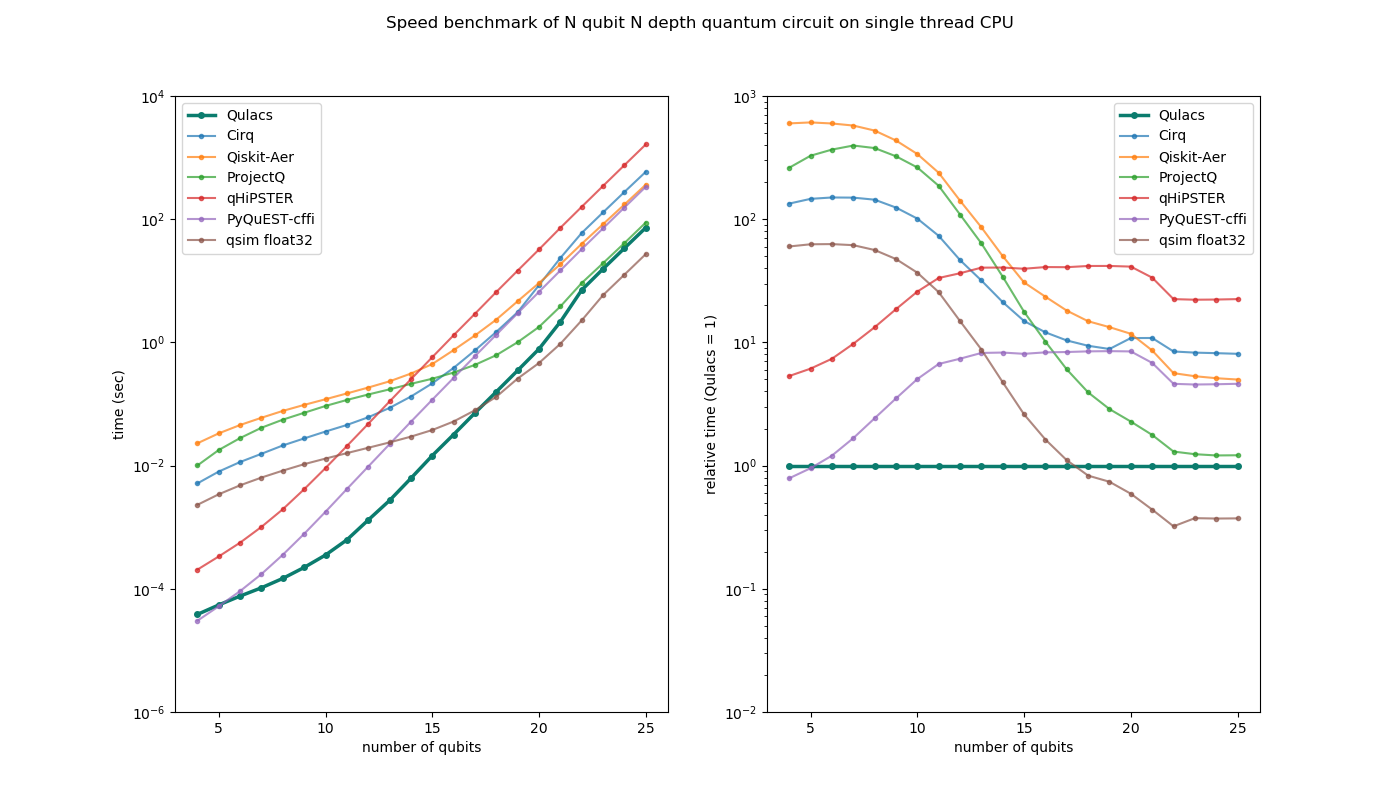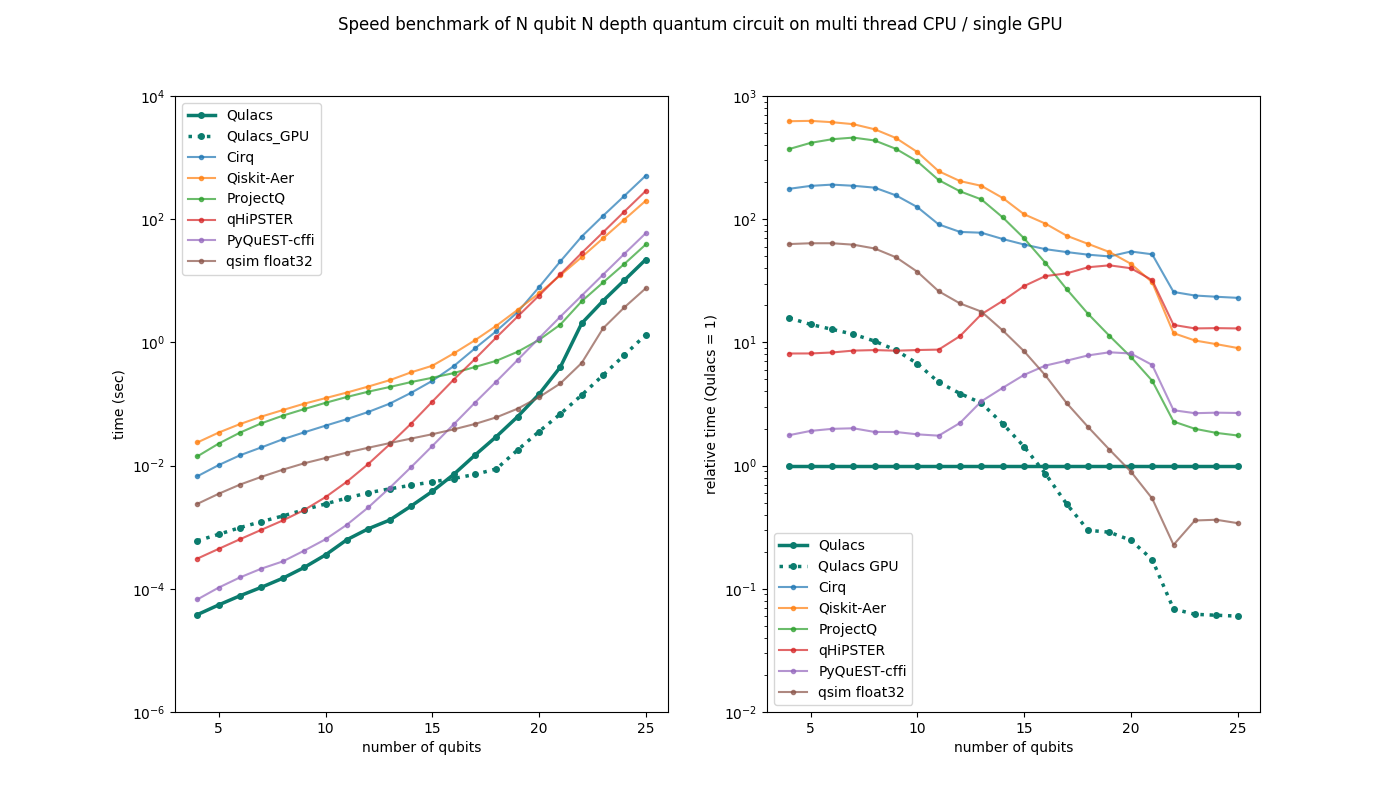Qulacs is a python/C++ library for fast simulation of large, noisy, or parametric quantum circuits.
Qulacs is licensed under the MIT license.
pip install qulacs
Notice: this command install the Qulacs binary which requires AVX2 features. If your computer doesn't support AVX2, the Python program using Qulacs installed by this command will almost certainly fail due to segmentation fault or something else. You should check your CPU and if it doesn't support AVX2 (i.e. older than Haswell) then you have to install Qulacs from the source code.
pip install git+https://github.com/qulacs/qulacs.git
If you have NVIDIA GPU with CUDA installed try:
pip install qulacs-gpu
- Fast quantum circuit simulation with parallelized C/C++ backend
- Noisy quantum gate for simulation of NISQ devices
- Parametric quantum gates for variational methods
- Circuit compression for fast simulation
- GPU support for fast simulation
- Many utility functions for research
- Compared following libraries on March, 2020
| Package | Version |
|---|---|
| Qulacs GPU | 0.1.9 |
| Cirq | 0.6.0 |
| Qiskit Aer | 0.3.4 |
| ProjectQ | 0.4.2 |
| qHiPSTER | latest master branch |
| Python interface of QuEST (PyQuest-cffi) | 3.0.0 |
| qsim | latest master branch |
- Azure NC6s_v3 (6vcpu / Mem112GiB)
- Intel(R) Xeon(R) CPU E5-2690 v4 @ 2.60GHz
- Tesla V100 PCIE (driver 440.33.01)
for each qubit number N:
- Apply simultaneous random single-qubit Pauli-X rotation
and then repeat:
- Apply CNOT(i,(i+1)%N) for all i in [0..N-1]
- Apply simultaneous random single-qubit Pauli-X rotation
for N times.
- execution time include time for creating quantum circuit
- benchmark was done with float64 precision (qsim was done with float32)
This benchmark was done with majour quantum circuit simulators with python interface.
Yao is quantum circuit simulator using Julia that is as fast as Qulacs.
Benchmark inculde Yao can be found here.
- C++ compiler (gcc or VisualStudio)
- gcc/g++ >= 7.0.0 (checked in Linux, MacOS, cygwin, MinGW, and WSL)
- Microsoft VisualStudio C++ 2015 or later
- python 2.7 or 3.x
- cmake >= 3.0
- git
- (option) CUDA >= 8.0
- (option) AVX2 support
If your system supports AVX2 instructions, SIMD optimization is automatically enabled.
If you want to enable GPU simulator, install qulacs through qulacs-gpu package or build from source.
Note that qulacs-gpu includes CPU simulator. You don't need to install both.
Qulacs is tested on the following systems.
- Ubuntu 16.04 / 18.04
- MacOS X Sierra
- Windows 10
If you encounter some troubles, see troubleshooting.
Install (Multi-thread without GPU)
python setup.py install
Install (Multithread with GPU. CUDA is required)
python setup_gpu.py install
Install (Single-thread without GPU. For launching multiple qulacs processes.)
python setup_singlethread.py install
Uninstall
pip uninstall qulacs
git clone https://github.com/qulacs/qulacs.git
cd qulacs
./script/build_gcc.sh
When you want to build with GPU, use build_gcc_with_gpu.sh.
git clone https://github.com/qulacs/qulacs.git
cd qulacs
script/build_msvc_2017.bat
When you want to build with GPU, use build_msvc_2017_with_gpu.bat. If you use MSVC2015, replace "2017" in file names to "2015".
See the following documents for more detail.
from qulacs import Observable, QuantumCircuit, QuantumState
from qulacs.gate import Y,CNOT,merge
state = QuantumState(3)
state.set_Haar_random_state()
circuit = QuantumCircuit(3)
circuit.add_X_gate(0)
merged_gate = merge(CNOT(0,1),Y(1))
circuit.add_gate(merged_gate)
circuit.add_RX_gate(1,0.5)
circuit.update_quantum_state(state)
observable = Observable(3)
observable.add_operator(2.0, "X 2 Y 1 Z 0")
observable.add_operator(-3.0, "Z 2")
value = observable.get_expectation_value(state)
print(value)If you want to run it on GPU, install GPU-enabled qulacs and replace QuantumState in the above codes to QuantumStateGpu.
#include <iostream>
#include <cppsim/state.hpp>
#include <cppsim/circuit.hpp>
#include <cppsim/observable.hpp>
#include <cppsim/gate_factory.hpp>
#include <cppsim/gate_merge.hpp>
int main(){
QuantumState state(3);
state.set_Haar_random_state();
QuantumCircuit circuit(3);
circuit.add_X_gate(0);
auto merged_gate = gate::merge(gate::CNOT(0,1),gate::Y(1));
circuit.add_gate(merged_gate);
circuit.add_RX_gate(1,0.5);
circuit.update_quantum_state(&state);
Observable observable(3);
observable.add_operator(2.0, "X 2 Y 1 Z 0");
observable.add_operator(-3.0, "Z 2");
auto value = observable.get_expectation_value(&state);
std::cout << value << std::endl;
return 0;
}Build command for g++:
g++ -O2 -I ./<qulacs_path>/include -L ./<qulacs_path>/lib <your_code>.cpp -fopenmp -lcsim_static -lcppsim_staticIf you want to run it on GPU, include cppsim/state_gpu.hpp and replace QuantumState with QuantumStateGpu.
Please cite this arXiv paper: Qulacs: a fast and versatile quantum circuit simulator for research purpose

